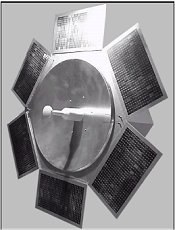|
The spacecraft will use the same
structure as the 600kg
AO-40 (known as Phase 3-D while on the ground) that was
launched into earth orbit in the fall of 2000. Like that satellite,
the project will involve an international collaboration of
AMSAT
chapters around the world and university groups.
Can Get
There from Here
The document P5A-to-Mars!
(712k pdf) describes the technical challenges and solutions
for such an ambitious mission. The propulsion system is quite
capable of sending the craft to Mars with careful planning
and execution of the orbital maneuvers. The required change
in velocity (delta-V) of 2.5km/s is obtainable from the same
400-N engine (N204 as oxidizer and MMH as fuel) used for AO-40.
(This highlights the famous observation by
Robert Heinlein that once you get into earth orbit you are
halfway to anywhere in the solar system!)
Like AO-40, the Mars probe will piggyback
on an Ariane 5 launch that will put it initially into a geostationary
transfer orbit. Unfortunately, as a secondary payload there
will be no control over the launch time and date, which can
complicate the maneuvers needed to reach Mars.
AMSAT Call
Home
Communication poses the greatest challenge
to the mission. A 2 meter antenna will be required on the
satellite and the group will take advantage of a surplus 20m
antenna station obtained from the German government.
When the satellite is properly pointed at
earth, smaller antennas will be able to pick up the signal.
However, if the satellite goes into, for example, a safe mode
and temporarily loses atitude control, it will have to rely
on an omni-directional antenna that will produce a very weak
signal on earth. So the large dish will be required for reliable
control of the satellite.
A Prelimary
Test in Orbit
The Phase
3-E project was also approved that will test in earth
orbit various techniques and technologies for the Mars mission.
Also, it will fulfill some of the mission goals that AO-40
did not achieve due to various problems with the engine mis-firing
and failures in some of the communciations systems.
Perhaps
Even an Amateur Lander
The P5A-to-Mars!
report also mentions the possibilities of a sub-satellite
that could be released once the spacecraft reaches Mars orbit.
The German
Mars Society has proposed a craft that would reach the
ground and release a balloon
to fly in the Martian wind and provide measurements of the
atmosphere.
AO-40 cost about $4 million, which was raised
from AMSAT, ham radio operators, and other sources. The Mars
probe will cost more than this and will required that get
considerable outside contributions.
[Addendum Aug.19.02 : Elon
Musk, the wealthy founder of Paypal and a space
enthusiast, is funding the Mars
Oasis project to put a lander on Mars. Hear his interview
on the
Space Show from Oct.24, 2001.]
Space
Music
Happenings in MusicSpace
More interesting items this month
from the world of Space Music (see also the previous
issue of the Space Gazette). Here are some space
music news and links of interest:
Space
Filk : The filk music publisher Random
Factors will be re-releasing Leslie Fish's Folksongs
for Folk Who Ain't Ever Been Yet (1976) and Solar Sailors
(1977) on a single CD called Folk Songs For Solar Sailors.
Joe Bethancourt is working on a space album called The
Great Big Way Out There.
Rock
in Space : Check out the great song Dream
(mp3, 1.6MB) by Mark Shuttleworth's brother, who is lead
singer of the South African band Motion. It was written
as a gift to his brother before Mark's flight to the Space
Station last April. More about the song and the group can
be found on the Dream
in Motion page at Mark's website First
African in Space.
Music
In Space : read the poignant story from saxaphone
teacher Kurt Hesig, The
Saxophone in Space (C) 1986, about his experience working
with astroanut Ron
McNair to obtain a sax for playing in space and
determining what techniques to use. McNair intended to play
a piece written for him by Jean-Michel Jarre during the Challenger
mission.
|


